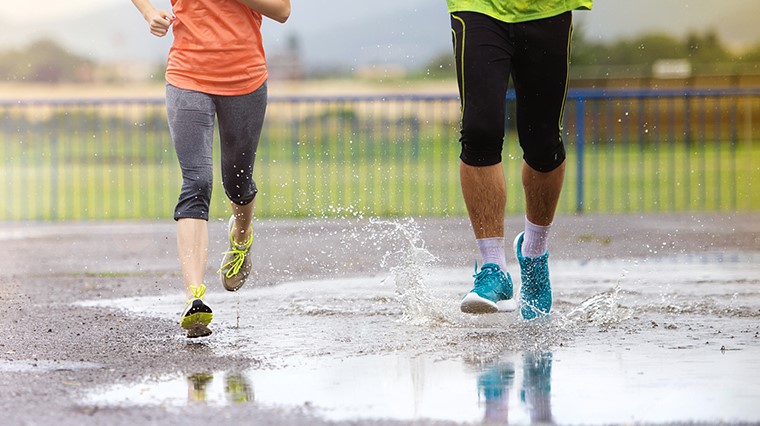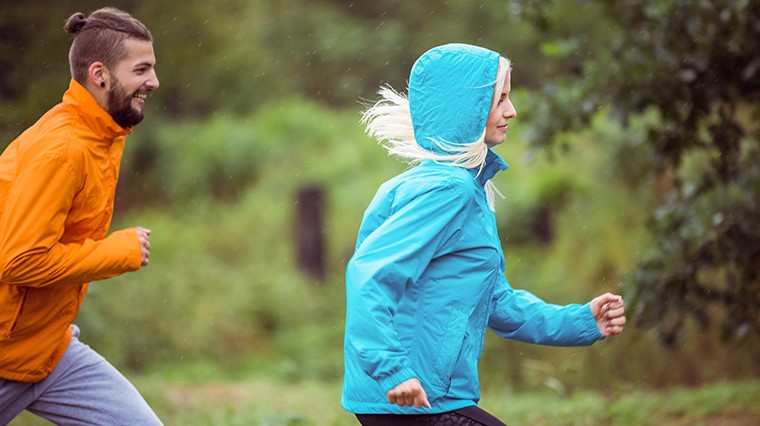10 Easy Wardrobe Hacks For Running In The Rain

Bucketing out? Don't get your laces in a twist. With our excuse-busting wet weather wardrobe tips, dressing for rain runs is easier than you think, and you may even love the feel of tackling slick roads and cloudy skies feet first.
By wearing the right running gear and consciously preparing for running in the rain, you can turn it into an invigorating experience, and we bet if anyone can rock bright-as-the-sun reflective running gear in style, you can.
Wear a brimmed running cap or visor
As tempting as it is to throw on a cuddly beanie, a running cap or visor with a bill provides an on-the-go shield to keep your face and eyes clear of rain and improve your vision. A fleece sweatband or Buff head tube can be worn over your ears beneath your cap to keep them cosy during chiller sweat sessions.
Bring on the reflective gear

There are tons of visibility accessories to boost your safety and stay noticed in cloudy conditions – from running vests and wristbands to reflective head tubes, caps and calf sleeves. This tech is often designed to capture and reflect vehicle headlights, keeping you visible on your road runs.
A water-resistant running headlamp lets you shine during light rain, without being too bulky or distracting. For running clothing, choose high-vis or bright, fluro colours and skip black or darker shades that will blend into the road or gloomy surroundings.
Dress for the temperature: Warm rain runs
Just because it’s raining doesn’t mean it’s an ice age out there, so dress for the temperature.
For warmer rain runs, avoid bundling yourself up in layer upon layer of clothing thinking it’ll keep you dry when it’s bucketing out. These will become soaked, heavy and if cotton, absorb the rain like a sponge and trap in sweat.
A sweat-wicking baselayer, running tank or running tee made of synthetic material like polyester will do the trick if the weather is warm and your runs are short, then top it off with a water-resistant outer shell to keep out the elements – we’ll chat more about this further down the track.
Rug up with layers (but don’t overdo it): Cold rain runs

If you’re covered in goosebumps rug up with these winter layering tips. Be aware you will get warmer as you hit foot to pavement and may need to strip down a layer, but do consider wearing running gloves to prevent your fingers freezing off on longer runs.
Taking advice from a sheep (baa!) and investing in woollen baselayers from brands like ioMerino for colder rain runs is another option – they’ll keep you cosy with their insulating properties and take the edge off the chill.
Keep the water out with a lightweight outer shell

You’re going to get wet – embrace it. A water-resistant or water-repellent running jacket or vest won’t keep you 100% dry, but it should protect your baselayer from getting soaked which is hard to recover from and will make a huge improvement on your comfort and overall experience, particularly in light to moderate rain.
Running-specific styles are breathable, won’t hinder your mobility and may also be wind-blocking to help you maintain an optimal body temperature.
Waterproof running jackets on the other hand act as your watertight armour in a downpour with sealed seams to prevent moisture sneaking in. The trade-off of keeping you bone dry by keeping water out is an increased risk of trapping sweat and heat in – but leading brands will try and find a balance by using technical fabrics teamed up with a membrane lining to keep it a touch airy.
Leave your trackies at home
Your trackies cocoon you up like a blanket when dry but will soak up moisture and hold it against your skin when running in the rain.
Compression tights are a way better option - made with sweat-wicking technical fabrics and coming in everything from above the knee short styles, to full hip-to-ankle coverage.
They're lightweight, fit like a second-skin for natural movement and yes, they will get wet – but water will act in the same way as sweat and dry quickly once you’re under cover.
Feel free to go short

Weirdly enough, technical (non-cotton) running shorts can be your preferred wet weather gear for runs – keeping you light and less compromised by moisture weighing you down.
Some runners prefer to wear compression shorts underneath loose-fitting running shorts for coverage and chafe protection in rainy conditions.
Choose the right socks
To prevent nasties like Athlete’s foot fungus from settling in between your toes, your feet must stay as dry as possible.
This is one of the reasons sweat-wicking running socks are essential – not purely for comfort but also for the health of your secret weapons – your feet.
Don’t get tempted by cheapie cotton socks – they’ll get squishy and stretched out as they absorb rather than wick away moisture, holding water against your skin and allowing blisters, fungus and infection to throw a party at the detriment of your feet.
Be smart about your shoe choice

You may be tempted to throw on daggy, ill-fitting sneakers to help preserve the life of your favourite running shoes but remember your feet deserve some love, and this will likely cause pain and injury.
Chances are your socks will get a little soggy in the rain, but breathable running shoes allow moisture to escape, decreasing your discomfort and risk of infection. Applying a hydrophobic, waterproof spray to footwear can help keep your feet dry and your running shoes protected from the elements.
Gore-Tex is handy for shorter runs in light rain, but...
Running shoe brands like Asics and Brooks occasionally release Gore-Tex (GTX) versions of their most popular road running shoes to act as a waterproof barrier for tackling wet or wintry conditions.
But alike with waterproof running jackets, the trade-off of keeping water out is locking moisture and sweat in. Although these top-of-the-line sportswear brands aim to give you the best of breathability and water-proofing, consider the conditions before lacing up.
Waterproof protection ends at the height the shoe does, at the heel collar. If your shoe is submerged in water or heavy rain sneaks in through the top, you'll be stuck with the 'squish' of a wet running sock, whether your shoe features Gore-Tex or not.
